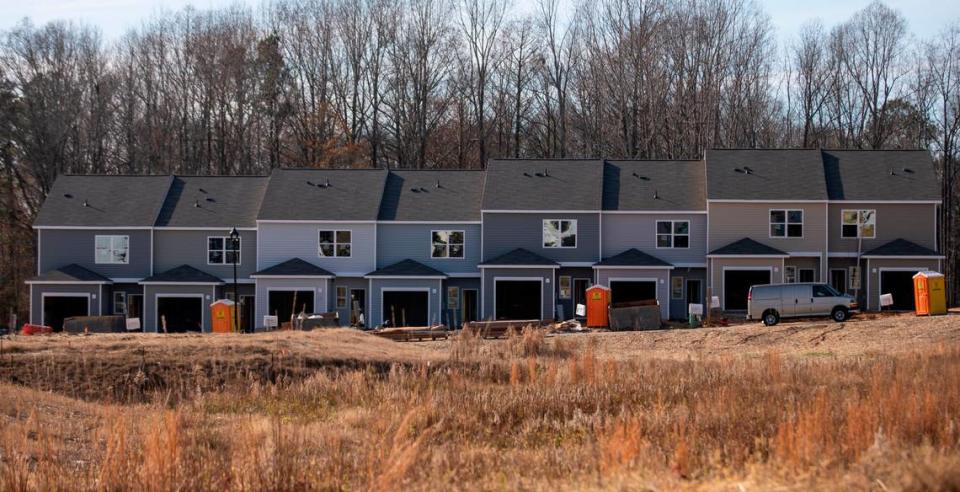Wake County again has NC’s fastest-growing towns, but maybe not the ones you think
As new residents have poured into Wake County in recent decades, population growth has moved around. Towns become hot, attracting developers who build homes and businesses that turn once small towns into teeming suburbs.
Now it’s Wendell’s turn, as growth has shifted toward the county’s relatively undeveloped east. Wendell grew nearly 16%, to 11,570, in the year ending last July 1, making it the fastest-growing town in not only the Triangle but in all of North Carolina, according to new estimates from the U.S. Census Bureau.
And Wendell’s eastern neighbor, Zebulon, wasn’t far behind. Zebulon grew nearly 13% during that year, to 7,974, making it the state’s second fastest growing.
As land becomes scarcer and more expensive in places such as Cary and Morrisville, developers and home buyers are looking east, where land is more plentiful but still a manageable drive to the rest of the Triangle down U.S. 64 and Interstate 87.
“A lot of that has to do with the property values,” said Michael Clark, Zebulon’s planning director. “It sounds cliche, but the town of Zebulon’s kind of the last frontier of Wake County, and in most situations we’re the most affordable of the communities in terms of entry-level homes.”
Wendell and Zebulon are reaching a stage that other Wake County towns have been through. Holly Springs was a rural cross-roads community of fewer than 1,000 residents in 1990. By 2007, it had grown to about 20,000 and signs welcomed visitors to the fastest-growing municipality in North Carolina.
Holly Springs is still growing, up 4.3% the year ending last July, to 43,524. But others, including Clayton and neighboring Apex and Fuquay-Varina, are now growing faster.
Like Holly Springs in the 1990s, Rolesville took off in the past decade, nearly tripling in size to 10,047 last summer. Its population grew 5% last year, still among the highest growth rates in the Triangle but less than a third the pace of Wendell.
More than Wendell Falls
Wendell’s recent growth was initially fueled by Wendell Falls, the massive planned community off Interstate 87 where construction began in 2015. The community will eventually have 3,500 to 4,000 homes, ranging from apartments to 4-bedroom houses that cost more than $700,000.
But developers are building other subdivisions in town as well, as people look along I-87 for places to live, said Bryan Coates, the town’s planning director.
“We have various neighborhoods now that are under construction,” Coates said. “Residents find our proximity to Raleigh and North Raleigh and N.C. State a very attractive location to live.”
Town officials were not surprised by the Census Bureau’s population estimates, if only because of the number of building permits Wendell has issued in recent years. The town is preparing for the growth, Coates said, with a new comprehensive plan and a separate master plan for parks and recreation.
“We’ve done some surveys recently where residents really want more open space and greenways,” he said. “So the town is working on fulfilling those through our capital improvement plan and budgeting and things like that.”
The leaders of both towns expect the growth to continue for a while.
“As of right now, between all the neighborhoods that have received approvals, we have over 3,000 dwelling units that have yet to begin construction,” Zebulon’s Clark said. “Which means our population is going to actually more than double in less than 10 years.”

Other growth trends in North Carolina
The census numbers released Thursday are the first look at population for cities and towns after the COVID-19 pandemic began in early 2020. Much attention has been focused on how large cities such as New York, Los Angeles and Chicago lost tens of thousands of residents in the year ending last July 1.
It’s not clear if those losses are permanent or reflect temporary changes in living patterns that may change again as the pandemic eases.
Two Triangle towns lost population, according to the census estimates. Carrboro and Chapel Hill, both home to thousands of UNC-Chapel Hill students and staff, shrank by less than 1% in the first year of the COVID-19 pandemic.
None of North Carolina’s 10 largest cities lost population, but growth was muted; all but two grew by less than 1% during the period covered by the census estimates. Here’s their populations on July 1, 2021, and the percent change in the previous year:
1. Charlotte: 879,709 (.3%)
2. Raleigh: 469,124 (.4%)
3. Greensboro: 298,263 (.2%)
4. Durham: 285,527 (.4%)
5. Winston-Salem: 250,320 (.4%)
6. Fayetteville: 208,778 (.1%)
7. Cary: 176,987 (.9%)
8. Wilmington: 117,643 (1.3%)
9. High Point: 114,086 (.2%)
10. Concord: 107,697 (1.8%)
In the Triangle, a dozen towns grew by 4% or more in the year ending July 1, 2021, putting them in the top 25 in the state. Here are their populations and growth rates:
Wendell: 11,570 (15.9%)
Zebulon: 7,974 (12.9%)
Angier: 5,703 (7.4%)
Fuquay-Varina: 36,736 (6.3%)
Clayton: 28,308 (6.1%)
Rolesville: 10,047 (5%)
Apex: 62,911 (4.9%)
Four Oaks: 2,331 (4.7%)
Holly Springs: 43,524 (4.3%)
Morrisville: 31,278 (4.2%)
Wilson’s Mills: 2,661 (4%)
Archer Lodge: 5,034 (4%)

